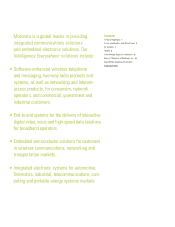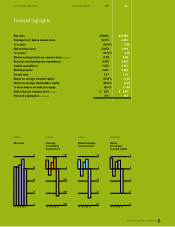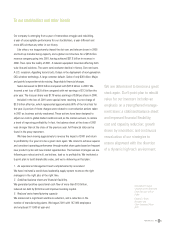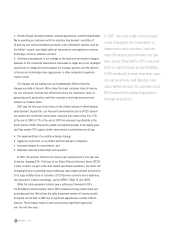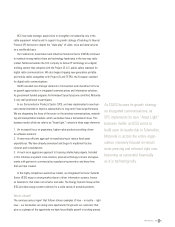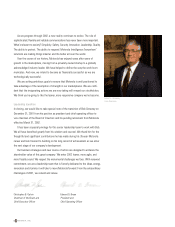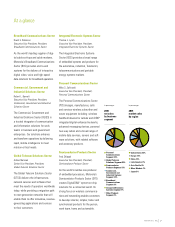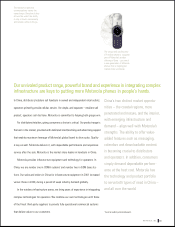Motorola 2001 Annual Report Download - page 5
Download and view the complete annual report
Please find page 5 of the 2001 Motorola annual report below. You can navigate through the pages in the report by either clicking on the pages listed below, or by using the keyword search tool below to find specific information within the annual report.
Our company is emerging from a year of tremendous struggle and rebuilding,
a year of unacceptable performance for our stockholders, a year different and
more difficult than any other in our history.
Like others, we inopportunely chased the dot-com and telecom boom in 2000
and built up manufacturing capacity and a global cost structure for a $45 billion
revenue company going into 2001, having achieved $37.6 billion in revenue in
2000. Then came the reality of 2001. A telecom equipment downturn affecting both
wire-line and wireless. The worst semiconductor decline in history. Dot-com busts.
A U.S. recession. Appalling terrorist acts. Delays in the deployment of next-generation
(3G) wireless technology. A large customer default. Sales of only $30 billion. Major
and painful corporation-wide resizing. Regrettable financial charges.
Sales decreased to $30.0 billion compared with $37.6 billion in 2000. We
incurred a net loss of $3.9 billion compared with net earnings of $1.3 billion the
prior year. The loss per share was $1.78 versus earnings of $.58 per share in 2000.
Included in the loss of 2001 were special items resulting in a net charge of
$3.3 billion after-tax, which represented approximately 80% of the total loss for
the year. A portion of these charges were related to cost-reduction actions taken
in 2001 as business activity weakened. These actions have been designed to
adjust our costs to global market conditions and, as the market recovers, to restore
a trend of improving profitability. In fact, the balance sheet at the close of 2001
was stronger than at the close of the previous year. Full financial data can be
found in the proxy statement.
We have been moving aggressively to reverse the impact of 2001 and return
to profitability. Our goal is to be a great stock again. We intend to achieve superior
and consistent operating performance through market share gains based on frequent
new product cycles and new market opportunities. The business strategies we are
following are robust and will, we believe, lead us to profitability. We instituted a
5-point plan to build shareholder value, and we’re delivering on that plan:
1. An experienced management team complemented by new talent.
We have instituted a world-class leadership supply system to ensure the right
managers in the right jobs at the right time.
2. Stabilized balance sheet and financial flexibility.
We generated positive operational cash flow of more than $1.9 billion,
reduced net debt by $4 billion and improved working capital.
3. Reduced costs/manufacturing capacity.
We announced a significant workforce reduction, and a reduction in the
number of manufacturing plants. We began 2001 with 147,000 employees
and employed 111,000 at year-end.
MOTOROLA, INC. 3
To our stockholders and other friends
We are determined to become a great
stock again. Our 5-point plan to rebuild
value for our investors includes an
emphasis on a strengthened manage-
ment team; a stabilized balance sheet
and improved financial flexibility;
cost and capacity reduction; growth
driven by innovation; and continuous
reevaluation of our strategies to
ensure alignment with the direction
of a dynamic high-tech environment.
Christopher B. Galvin
Chairman of the Board and
Chief Executive Officer
(right)
Edward D. Breen
President and
Chief Operating Officer
(left)


